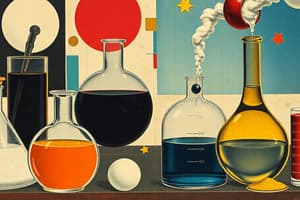Podcast
Questions and Answers
What are the three physical states of matter?
What are the three physical states of matter?
- Ice, steam, water
- Solid, liquid, gas (correct)
- Gas, liquid, plasma
- Solid, gaseous, plasma
How do solids differ from liquids and gases?
How do solids differ from liquids and gases?
- Solids have no definite volume but definite shape
- Solids have definite volume and definite shape (correct)
- Solids have definite volume but no definite shape
- Solids have no definite volume or shape
Why is understanding the relation between the structure of solids and their properties important?
Why is understanding the relation between the structure of solids and their properties important?
- To convert solids into gases
- To liquefy gases
- To make liquids more stable
- To synthesize new solid materials with different properties (correct)
Where does the term 'crystal' originate from?
Where does the term 'crystal' originate from?
What are the two major types of solids based on the arrangement of their constituents?
What are the two major types of solids based on the arrangement of their constituents?
What was the term 'crystal' first applied to?
What was the term 'crystal' first applied to?
Which type of solid has atoms or molecules tightly held in an ordered arrangement?
Which type of solid has atoms or molecules tightly held in an ordered arrangement?
What are the three different physical states in which matter may exist?
What are the three different physical states in which matter may exist?
Explain how solids differ from liquids and gases in terms of volume and shape.
Explain how solids differ from liquids and gases in terms of volume and shape.
What types of substances are commonly found in the solid state in our daily lives?
What types of substances are commonly found in the solid state in our daily lives?
Why is it important to understand the relation between the structure of solids and their properties?
Why is it important to understand the relation between the structure of solids and their properties?
How are the atoms, molecules, or ions arranged in solids?
How are the atoms, molecules, or ions arranged in solids?
Flashcards are hidden until you start studying
Study Notes
Physical States of Matter
- Matter can exist in three physical states: solid, liquid, and gas.
Characteristics of Solids
- Solids have definite volume and definite shape.
- Atoms, molecules, or ions in solids are tightly held in an ordered arrangement.
Types of Solids
- Examples of solids include diamond, metals, and plastics.
- Most substances used in daily life are in the solid state.
Importance of Understanding Solid Structure
- Understanding the relation between the structure of solids and their properties is useful in synthesizing new solid materials with different properties.
Classification of Solids
- Solids can be classified into two major types based on the arrangement of their constituents.
- The two types of solids are:
Crystalline Solids
- The term "crystal" comes from the Greek word "krystallos", meaning clear ice.
- Crystalline solids are bounded by many flat, symmetrically arranged faces.
Amorphous Solids
- No specific arrangement of their constituents.
Studying That Suits You
Use AI to generate personalized quizzes and flashcards to suit your learning preferences.




